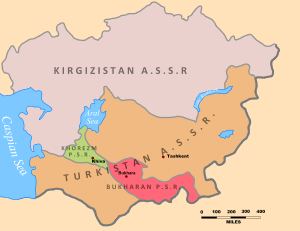Kazakh famine of 1919–1922
| Kazakh famine of 1919–22 | |
|---|---|
 Map of the Kirghiz ASSR and Turkestan ASSR, 1922 | |
| Country | Soviet Union |
| Location | Kirghiz ASSR and Turkestan ASSR |
| Period | 1919–1922 |
| Total deaths | 400,000[1]–750,000[2] |
| Observations | Droughts, failures of collectivization and Prodrazvyorstka |
| Relief | Aid provided by the Workers International Relief, and American Relief Administration |
| Impact on demographics | 19% to 33% of the Kazakh population died |
| Preceded by | Russian famine of 1891–92 |
| Succeeded by | Kazakh famine of 1932–33 |
The Kazakh famine of 1919–1922,[1] also referred to as the Turkestan famine of 1919–1922,[3] was a period of mass starvation and drought that took place in the Kirghiz ASSR (present-day Kazakhstan) and Turkestan ASSR as a result of war communism policy,[4][5] in which 400,000[1] to 750,000[2] peasants died. The event was part of the greater Russian famine of 1921–22 that affected other parts of the USSR,[6] in which up to 5,000,000 people died in total.[7][8]
Background
The famine was caused by severe intermittent drought conditions, aggravated by the Russian Civil War and the policy of Prodrazvyorstka adopted by the Soviet government.[1]
Famine
By 1919, roughly half of the population was starving. Epidemics of typhus and malaria were also widespread. The greatest percentage of losses of the Kazakh population was in Aktyubinsk, Akmola, Kustanai and Ural provinces.[2] According to the estimates of demographers, about 19% of the population died, which is equivalent to 400,000 people.[1] However, Turar Ryskulov, chairman of the Central Electoral Committee of the Turkestan Autonomous Soviet Socialist Republic, estimated that "about one third of the population must have died", which is equivalent to 750,000 people.[2]
Relief
The Soviet government invited international organizations, such as Workers International Relief to provide relief[9], and the American government provided aid to starving Kazakhs from 1920 to 1923 through the American Relief Administration.[6] 1923 and 1924 were turning points in the restoration of the national economy and the hardest hitting phase of the famine ended in 1922. However, shortages, starvation, and illness continuedthroughout 1923 and into 1924.[1]
See also
References
- 1 2 3 4 5 6 (in Russian) Krasnobaeva, N. L. (2004). "Население Казахстана в конце XIX-первой четверти XX века [Population of Kazakhstan from late 19th to early 20th centuries]". Retrieved 2016-09-26.
- 1 2 3 4 Everett-Heath, Tom (8 December 2003). Central Asia: Aspects of Transition. Routledge. p. 7. ISBN 9781135798239.
- ↑ "Famine: perspectives from the past and present". Foundation Les Treilles. 25 February 2013. Retrieved 1 May 2017.
- ↑ Mizelle 2002, p. 18.
- ↑ Werth, Nicolas; Panné, Jean-Louis; Paczkowski, Andrzej; Bartosek, Karel; Margolin, Jean-Louis (October 1999), Courtois, Stéphane, ed., The Black Book of Communism: Crimes, Terror, Repression, Harvard University Press, pp. 92–97, 116–21, ISBN 978-0-674-07608-2
- 1 2 Millar 2004, p. 56.
- ↑ Millar 2004, p. 270.
- ↑ Haven, Cynthia (4 April 2011). "How the U.S. saved a starving Soviet Russia: PBS film highlights Stanford scholar's research on the 1921-23 famine". Stanford News Service. Retrieved 28 April 2017.
- ↑ Draper, Theodore (1960). American Communism and Soviet Russia. Transaction Publishers. p. 176. ISBN 9781412816915.
Sources
- Millar, James R. (2004). Encyclopedia of Russian History Volume 2: A-D (PDF). New York, USA: Macmillan Reference. ISBN 0-02-865907-4. Archived from the original (PDF) on 2017-04-29.
- Mizelle, Peter Christopher (May 2002). "Battle with Famine:" Soviet Relief and the Tatar Republic 1921-1922. District of Columbia, USA: University of Virginia.
Further reading
- Mustafa Shokay, "Туркестан под властью Советов. К характеристике диктатуры пролетариата", Paris, 1935, excerpts published in Prostor, 1992.N9-10.C.101-112
- Мусаев, Бауыржан Алпысбаевич; Голод в первой половине 20-х годов ХХ века в Казахстане: исторический, социально-политический анализ, Ph.D. thesis, Uralsk, 2005
- Thomas, Alun (2015). "Kazakh Nomads and the New Soviet State, 1919–1934". University of Sheffield. Retrieved 2016-09-26.
- Cameron, Sarah (2011). "The Hungry Steppe: Soviet Kazakhstan and the Kazakh Famine, 1921–1934". Yale University.
- "Истина о голоде в документах Актюбинского областного архива | Управление архивов и документации Актюбинской области". 2012-05-15. Retrieved 2016-09-27.